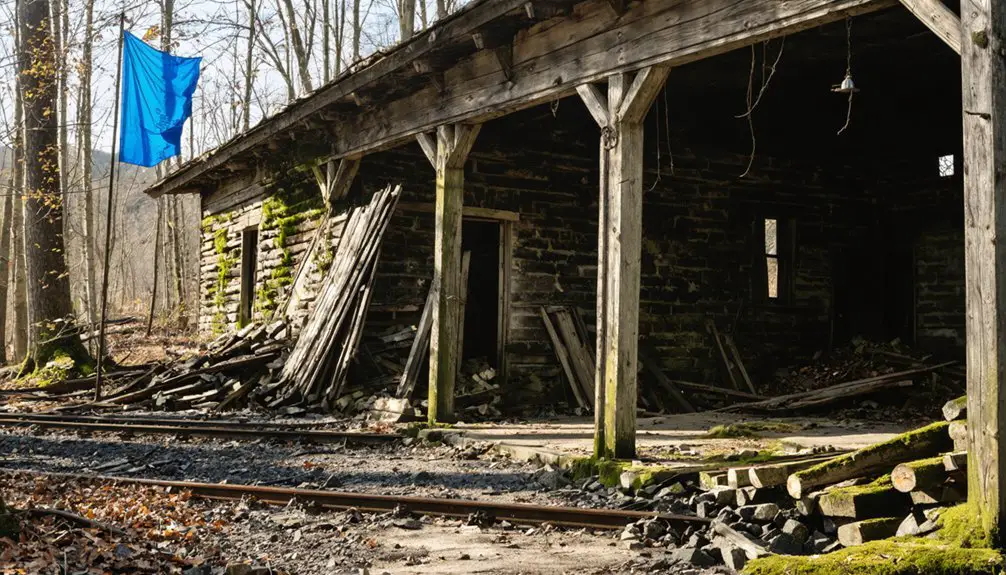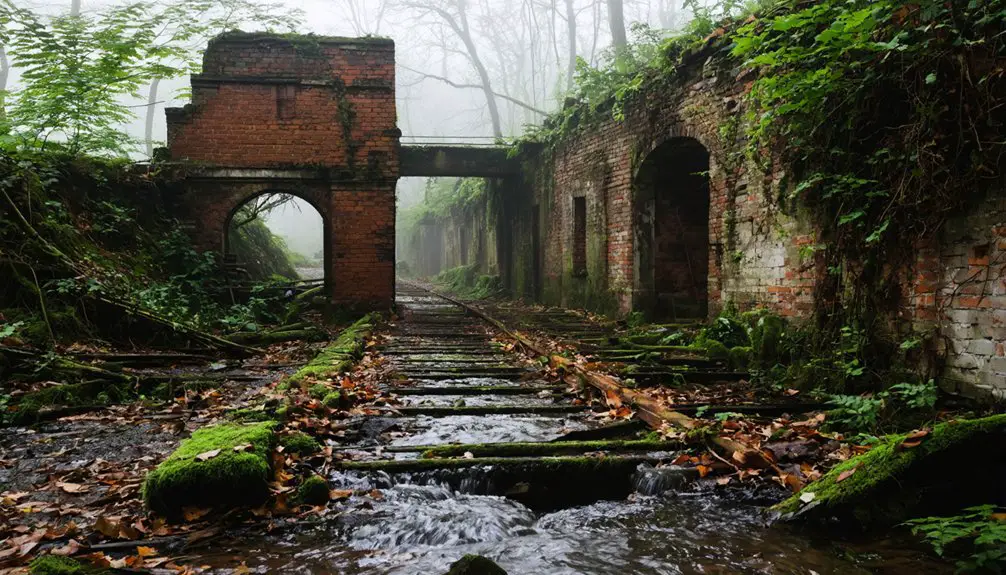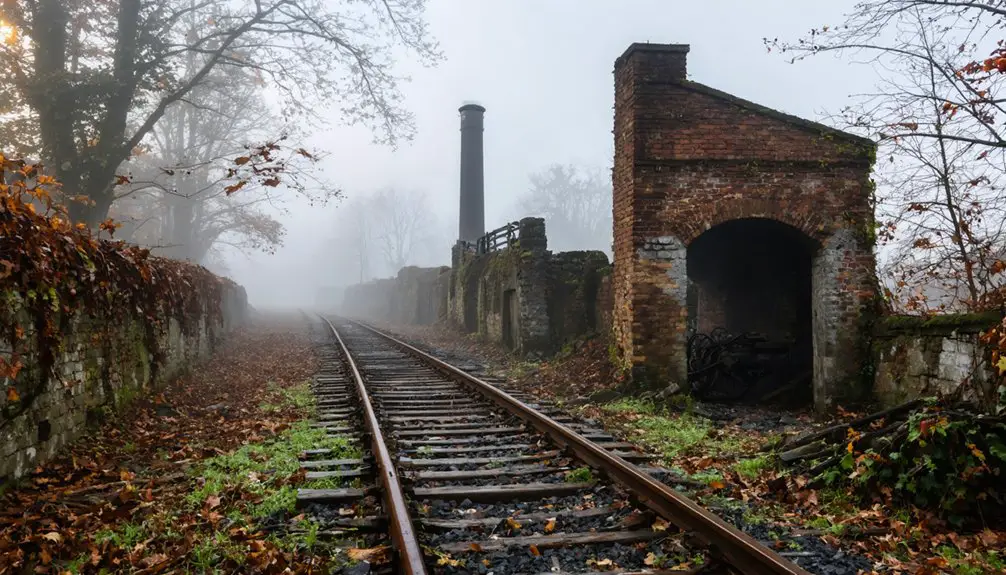You’ll find Fulton Run‘s haunting remains in central Pennsylvania, where a once-thriving coal town met its end in 1962 due to devastating underground fires. The Rochester & Pittsburgh Coal & Iron Company built this community around rich coal seams, including the 10-12 foot Freeport vein, providing homes and amenities for mining families. Today, scattered ruins, mine entrances, and Victorian graves tell a powerful story of coal heritage and community resilience beneath the scorched earth.
Key Takeaways
- Fulton Run transformed from a prosperous coal mining town into a ghost town after mining operations ceased in 1934.
- Underground coal fires starting in 1962 forced evacuations and rendered the area uninhabitable with soil temperatures reaching 900°F.
- Remnants include abandoned mine entrances, coal spoil piles, and scattered foundations from the original coal town structures.
- The community once thrived with company-built housing, stores, and social gathering places before economic decline forced residents to leave.
- Victorian-era gravestones in local cemeteries and archaeological discoveries of mining tools preserve the town’s coal mining heritage.
The Rise of a Mining Community
While farmers initially undervalued the coal-rich lands of Fulton Run, selling acreage for as little as $10-20, the area’s mining potential soon became evident through its remarkably thick coal seams, including the 10-12 foot Freeport vein.
Early farmers sold their coal-rich lands for pennies, unaware the thick Freeport seam would transform Fulton Run forever.
The area held particular significance due to its position near the Wells Tannery community, which supplied many workers for the mines.
You’d have witnessed a rapid transformation as the Pittsburgh-Buffalo company strategically acquired land and established massive mining operations.
The community dynamics shifted dramatically when the Rochester & Pittsburgh Coal & Iron Company developed the area into a proper coal town, complete with worker housing and social amenities. The mines yielded impressive output comparable to the Morris Run operations, which had produced over 323,000 tons in their first decade.
Under their local governance, the town grew around impressive infrastructure including the 36×24 foot Rachel and Agnes shafts.
Life in Early Fulton Run
Despite their modest circumstances, early Fulton Run residents forged a close-knit mining community centered around simple wooden homes and essential institutions.
You’d find families living in close quarters, sharing basic accommodations without indoor plumbing, while relying heavily on company-provided housing and stores for their daily needs.
Life revolved around the demanding rhythm of mine work, with men spending long hours underground while women managed domestic duties. Similar to Centralia’s peak era, the town had numerous saloons and hotels catering to the mining workforce.
Children split their time between seasonal schooling and helping at home. Community gatherings at the local church and schoolhouse strengthened social bonds, and daily routines often included shopping at the general store. Much like Yellow Dog Village, the mining company established a company town where workers depended entirely on their employer.
Despite challenging conditions and health risks from mining, residents maintained strong community ties, with many families staying for generations before the town’s eventual decline.
Mining Operations and Industrial Growth
You’d have found Fulton Run’s miners using room-and-pillar extraction methods throughout the coalfield’s peak years, with teams carefully removing bituminous coal while leaving strategic support columns to prevent cave-ins.
The underground work conditions demanded skilled labor and constant vigilance, as miners navigated dark tunnels illuminated only by headlamps while operating mechanical coal cutters and dealing with ventilation challenges. These retreat mining operations allowed recovery rates exceeding 70% of available coal by systematically removing support pillars and allowing controlled roof collapse.
Your ancestors witnessed significant technological progress in mining operations, as the power systems evolved from basic 6,600-volt setups to more robust 23,000-volt installations that supported advanced equipment and improved safety measures. By 1917, the mine’s daily capacity reached an impressive 6,000 tons of coal, requiring three full shifts of workers to maintain production.
Coal Extraction Methods Used
Throughout the late 19th century, Fulton Run’s coal mines primarily relied on deep mining methods to extract coal from extensive underground seams.
You’d find sophisticated vertical shaft mining operations, complete with hoist houses and air shafts that penetrated deep into the earth. The mines employed room and pillar mining systems, strategically leaving coal pillars to support the mine’s roof while extracting the maximum amount of coal possible. The Rochester and Pittsburgh Coal Company dominated local mining operations after incorporating in 1881.
To keep miners safe underground, they installed powerful electrical fans that maintained constant airflow through the complex network of tunnels. The need for proper ventilation became critical after Jesse Fell’s discovery revolutionized anthracite coal burning in 1808.
As mining technology advanced, the operations required significant power upgrades, jumping from 6,600 to 23,000 volts to run the increasingly sophisticated equipment.
These methods helped companies like Morris Run and Fall Brook extract millions of tons of coal, fueling the region’s industrial growth.
Work Conditions Underground
While Fulton Run’s mines drove Pennsylvania’s industrial expansion, conditions underground proved treacherous for the workforce who labored in dark, damp tunnels for up to 12 hours daily.
You’d find miners battling constant mining hazards: methane gas accumulation, water seepage, and the ever-present risk of tunnel collapse. The cramped spaces forced workers into uncomfortable crouched positions as they extracted coal, their pay tied to production quotas despite the dangers.
To combat these harsh conditions, ventilation systems powered by surface plants circulated fresh air through the shafts, while electric pumps fought against groundwater infiltration.
Even with these improvements, the physical toll on miners remained severe. They’d rely on rudimentary safety protocols and basic communication systems, working tirelessly in confined spaces to support their families and fuel the region’s growing industrial needs.
Equipment and Technology Advancements
As Fulton Run’s mining operations expanded in the early 1900s, technological advances transformed the industry from primitive hand tools to sophisticated mechanized systems. You’d have seen dramatic changes in drilling techniques, from manual augers and copper-ended tamping bars to continuous mining machines that could efficiently extract coal while improving worker safety. Underground illumination improved as miners transitioned from oil-based Sunshine lamps to brighter alternatives.
Transportation innovations revolutionized how coal moved from mine to market. While early operations relied on horse-drawn wagons and treacherous river arks, the arrival of railways and mechanized conveyor systems streamlined the entire process. The East Broad Top Railroad became essential for bulk shipments, and new loading docks with tipples enabled faster turnaround times. Coke ovens at Lucerne became a crucial part of the coal processing infrastructure.
Inside the mines, six-wheel motorized carts replaced manual hauling, while electric-powered machinery and conveyor belts modernized processing operations at the surface.
Social Fabric and Cultural Heritage

During its heyday in the 19th century, Fulton Run embodied the quintessential coal mining community, where generations of families forged deep social bonds through shared labor and daily life.
You’ll find evidence of community resilience in the town’s social fabric, which centered around churches, local halls, and informal gatherings that strengthened neighborly ties.
The town’s cultural memory lives on through oral histories and local legends that paint a vivid picture of Appalachian mining culture.
Folk songs, storytelling traditions, and seasonal festivals brought residents together, creating lasting connections that transcended the daily challenges of mining life.
Even as economic hardship forced many families to leave, those who stayed maintained strong social networks until the town’s eventual abandonment, demonstrating the enduring spirit of coal town communities.
Economic Decline and Population Loss
As coal mining operations in Fulton Run mechanized and demand declined, you’d have witnessed the rapid disappearance of mining jobs that once sustained generations of local families.
You would’ve seen workers and their families forced to abandon their homes and seek employment elsewhere, mirroring the exodus patterns of other Pennsylvania coal towns.
The mass departure of workers created a domino effect, causing local businesses to shutter and public services to become unsustainable for the few remaining residents.
Mining Jobs Vanish Fast
When coal demand shifted away from Pennsylvania’s Broad Top Coalfield in the mid-20th century, Fulton Run’s mining jobs disappeared at an alarming rate. You’d have witnessed a massive job displacement as mines like Wishart near Wells Tannery shut down or drastically reduced their workforce. This economic shift hit the community particularly hard, transforming a once-thriving mining town into a shell of its former self.
- Traditional room-and-pillar mining gave way to mechanized operations, requiring fewer workers.
- Local businesses suffered as mining income dried up.
- Property values plummeted while poverty rates climbed.
- Young families left town seeking work elsewhere.
- Community services and institutions faced cuts due to dwindling tax revenue.
The rapid decline in mining employment left Fulton Run struggling to adapt, with limited options for economic diversification.
Workers Leave Town Empty
The exodus from Fulton Run accelerated sharply after the mining industry’s collapse, leaving behind a landscape of abandoned buildings and shattered dreams.
You’d have seen waves of worker migration as families packed up their homes, seeking opportunities in more prosperous cities. The town’s economic fabric unraveled quickly – shops closed their doors, municipal services dwindled, and community bonds weakened.
As businesses tied to mining operations shut down, community abandonment became inevitable. You couldn’t sustain a livelihood in a place where job prospects had vanished.
The social problems that followed – including a rising drug trade and crumbling infrastructure – only hastened the departure of remaining residents. Without economic diversity to fall back on, Fulton Run’s population continued to shrink until only empty streets and deteriorating buildings remained.
Environmental Impact and Land Changes

Underground coal fires ravaging Fulton Run since 1962 have devastated the local environment, turning a once-thriving community into an unstable wasteland.
The environmental degradation you’ll witness today includes soil temperatures reaching 900°F and widespread land instability that’s made the area uninhabitable.
Scorching underground temperatures and unstable terrain have transformed this once-livable region into a dangerously inhospitable zone.
- Toxic gases seep through ground cracks, creating hazardous conditions and killing surface vegetation.
- The persistent fire releases greenhouse gases and pollutants, severely impacting local air quality.
- Ground subsidence has forced the closure of Route 61 and created dangerous sinkholes.
- Contaminated groundwater threatens nearby streams and wetlands.
- Soil sterilization prevents new growth, leaving barren landscapes.
You can’t safely build or live here anymore – the underground inferno continues to reshape the land, with experts projecting another 250 years of burning ahead.
Remnants and Historical Sites
Despite nearly a century of abandonment, scattered remnants of Fulton Run‘s once-bustling coal town still dot the landscape, offering glimpses into its industrial past.
You’ll find ghostly remnants of mine entrances and spoil piles from operations that closed in 1934, while historical markers guide you through the town’s coal heritage.
Though most original houses were moved or dismantled, their foundations and buried rail ties trace the community’s layout.
Local cemeteries preserve the stories of former residents through Victorian-era gravestones, while archaeological surveys have unearthed household items and mining tools.
Though time and vegetation have obscured many structures, you can still discover brick fragments, foundation stones, and mining infrastructure ruins.
These physical traces, along with artifacts in regional museums, help piece together Fulton Run’s forgotten narrative.
Legacy in Pennsylvania’s Coal Region

While Fulton Run’s physical structures have largely vanished, its lasting influence on Pennsylvania’s coal region remains evident through economic, social, and cultural legacies.
You’ll find the community resilience and labor heritage of this region woven into the very fabric of Pennsylvania’s industrial history.
- Local mining operations like Morris Run and Fall Brook contributed millions of tons of coal, powering America’s industrial revolution.
- The United Mine Workers’ organizing efforts near Fulton Run helped establish stronger labor rights across the industry.
- Mining families created tight-knit communities that supported each other through economic ups and downs.
- Advanced mining techniques developed here influenced practices throughout the coal region.
- Today’s local historians work tirelessly to preserve the stories of mining culture and community spirit.
Frequently Asked Questions
Are There Any Documented Paranormal Activities or Ghost Sightings in Fulton Run?
Despite a million ghost stories from Pennsylvania’s coal towns, you won’t find any documented ghost encounters or spectral evidence in Fulton Run’s records. It’s one ghost town that’s missing actual ghost stories.
What Happened to the Town’s Cemetery and Burial Records?
You’ll find minimal documented evidence of the cemetery’s preservation or burial records – they were likely lost when the town was abandoned, or merged into broader county or church archives.
Can Visitors Legally Explore the Remaining Structures of Fulton Run Today?
Like 67% of Pennsylvania’s ghost towns, you can’t legally explore these structures. Ghost town regulations restrict visitor access since the site’s on private property without documented permission for public entry.
Were There Any Notable Crimes or Accidents That Contributed to Abandonment?
While you won’t find specific crime history or accident reports for Fulton Run itself, neighboring coal towns like Whiskey Run experienced violent crimes and mining disasters that affected the broader region’s decline.
Do Any Original Fulton Run Families Still Own Property There?
You won’t find evidence of original families maintaining property ownership there today. Mining town patterns suggest they likely moved away permanently, with properties either abandoned or acquired by the state.
References
- https://www.iup.edu/library/departments/archives/coal/mines-and-company-towns/the-company-town-of-whiskey-run.html
- https://www.youtube.com/watch?v=Qj5LjacccJ0
- https://pabucketlist.com/abandoned-places-in-pa-you-can-legally-explore/
- https://en.wikipedia.org/wiki/Centralia
- https://en.wikipedia.org/wiki/List_of_ghost_towns_in_Pennsylvania
- https://www.mariannapa.org/History
- https://www.joycetice.com/1883/1883c05.htm
- http://coalzoom.com/article.cfm?articleid=31216
- https://npshistory.com/publications/aih-sw-pa/indiana-co.pdf
- https://www.iup.edu/library/departments/archives/coal/mines-and-company-towns/the-company-town-of-lucerne.html



